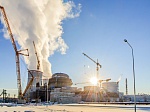03.04.2019
INFORMATION AND PUBLIC RELATIONS DEPARTMENT OF LENINGRAD NPP
The Leningrad NPP: the brand new extra-heavy 5th power block with a VVER-1200 reactor has reached an output of 5 billion kWh
Since the moment it was connected to the Unified Energy System of Russia, the brand new extra-heavy Leningrad NPP 5th power block with a VVER-1200 reactor (an affiliate company of the Rosenergoatom Joint-Stock Company, a part of the Rosatom’s Electric Power Division) had reached an output of five billion kilowatt-hours. As of April 3, the output has exceeded 5 billion 7 million kWh.
‘Today, a new date has marked the history of the Leningrad nuclear power plant. We have produced our first five billion kilowatt-hours of electric power. Without any doubt, the main success factors are an excellent design, innovative technologies, work of thousands of people – developers, construction, installation and machine settling workers and, certainly, the Leningrad NPP staff. This critical performance indicator was accompanied by rigid adherence to the safe, reliable and environment-friendly operating standards of the new power block’, Vladimir Pereguda, the director of the Leningrad NPP, said.
The electric power delivered by the new power block is highly sought-after for the development of the North-Western region, which is now having an array of major investment projects. Alexander Drozdenko, the head of the region, has continuously stressed the importance of the Leningrad NPP for the area: ‘The operational launch of the new Leningrad NPP-2 power blocks boosts our opportunities for power-consuming industries development, including but not limited to the high-tech industries and the digital transformation projects’.
The economic benefit of the power block’s operational launch represented by extra tax incomes into the consolidated budget of the Leningrad Region is estimated at over 3 billion rubles annually.
The dwellers of Sosnovy Bor neighbouring the Leningrad NPP enjoy both extra jobs and the lowest heating costs – 388 rubles per gigacalorie.
It is important to note that the generator of the innovative Leningrad NPP 1st VVER-1200 power block was synchronized with the network on March 9, 2018, which was followed by all scheduled trials and low power testing as the power block was operated on different levels varying between 30% and 100%. In October 2018, the Leningrad NPP 1st VVER-1200 power block was commissioned, and in early 2019 it entered the capacity sales market. Its timely commissioning has enabled the Leningrad NPP to smash its target for 2018 by 5.05% and make a significant contribution into the new record of the Rosenergoatom Joint-Stock Company.
As for 2019, The Federal Antimonopoly Service has set the bar for the Leningrad NPP to produce 28 billion 30 million kWh of electric power, which is 2% higher than the plan for 2018. The majority of this output – almost 30% - is expected from the new power block.
Compared to the traditional power blocks (VVER-1000), the design used for the Leningrad NPP 3+ generation one has a lot of merit, which improves its economic efficiency and safety. For instance, the electric power capacity of the reactor assembly has been increased by 20%, from 1000 to 1200 megawatt; the lifespan of the core equipment has doubled from 30 to 60 years. Additionally, the power block complies with the world’s highest standards regulating nuclear safety.
The Leningrad NPP-2 project is a reference one for many international projects implemented by the Rosatom State Corporation, such as the Belarusian NPP, the Paks-2 NPP, the El Dabaa NPP, the Hanhikivi-1 NPP, etc.
The Leningrad NPP is the country’s first plant with RBMK-1000 reactors (uranium-graphite circuit-type reactor running on thermal neutrons). The decision that marked its construction was taken in September 1966 by a resolution of the Central Committee of the Communist Party of the USSR and the Council of Ministers No. 800-252. According to that document, the Leningrad NPP was supposed to become a core in a network of nuclear power plants with RBMK-1000 reactors that were supposed to produce a substantial share of electric power. The construction of the Leningrad NPP was going well, and by 1973 the first power block was fully erected. On December 23, 1973, following stable 72-hours’ operation at the capacity of 150 megawatt, the State Commission signed the acceptance certificate stating that the first power block of the Leningrad nuclear power plant is commissioned for pilot production.


 career
career Innovations
Innovations Projects
Projects INTERNATIONAL BUSINESS
INTERNATIONAL BUSINESS